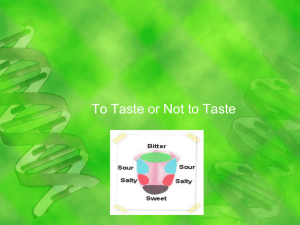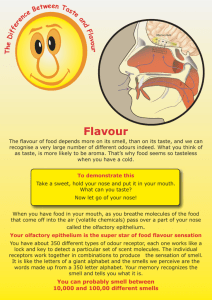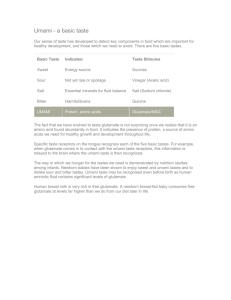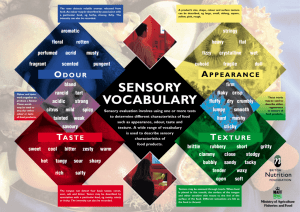Masking of Bitter Tastes by Luke Wylie Introduction:
advertisement
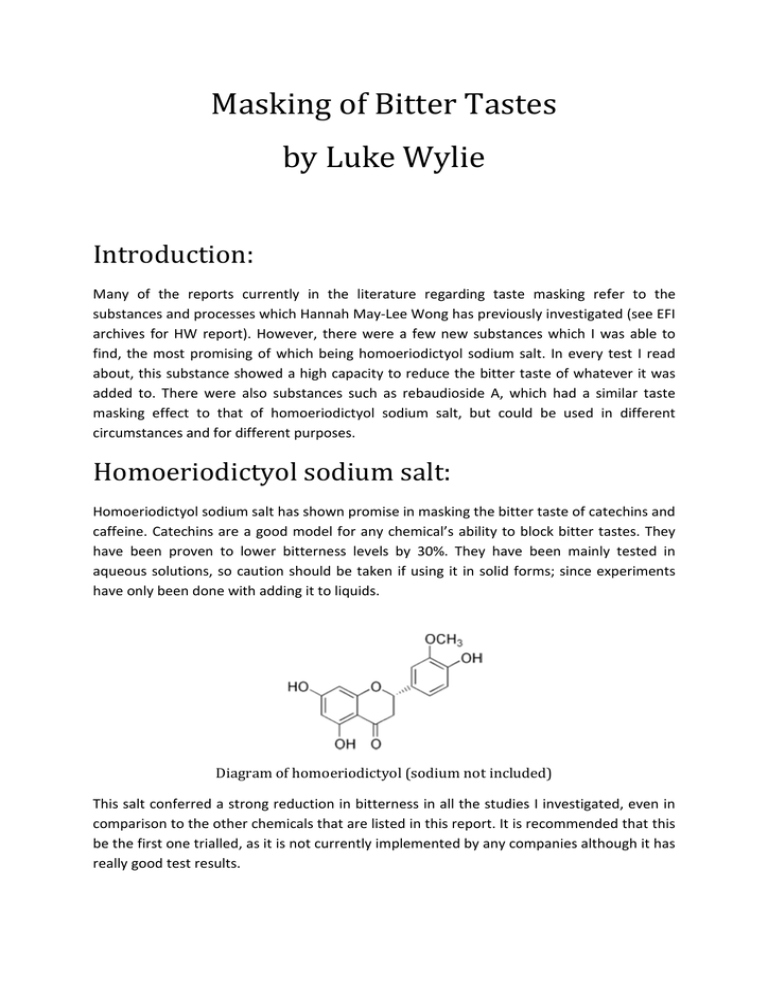
Masking of Bitter Tastes by Luke Wylie Introduction: Many of the reports currently in the literature regarding taste masking refer to the substances and processes which Hannah May-Lee Wong has previously investigated (see EFI archives for HW report). However, there were a few new substances which I was able to find, the most promising of which being homoeriodictyol sodium salt. In every test I read about, this substance showed a high capacity to reduce the bitter taste of whatever it was added to. There were also substances such as rebaudioside A, which had a similar taste masking effect to that of homoeriodictyol sodium salt, but could be used in different circumstances and for different purposes. Homoeriodictyol sodium salt: Homoeriodictyol sodium salt has shown promise in masking the bitter taste of catechins and caffeine. Catechins are a good model for any chemical’s ability to block bitter tastes. They have been proven to lower bitterness levels by 30%. They have been mainly tested in aqueous solutions, so caution should be taken if using it in solid forms; since experiments have only been done with adding it to liquids. Diagram of homoeriodictyol (sodium not included) This salt conferred a strong reduction in bitterness in all the studies I investigated, even in comparison to the other chemicals that are listed in this report. It is recommended that this be the first one trialled, as it is not currently implemented by any companies although it has really good test results. Rebaudioside A: What is it? A sweetener that is 200 times sweeter than sucrose, this chemical is also healthier as a result of only needing less concentrations and not effecting blood sugar in diabetics as much. It acts in a similar way to sucrose as it does contain subunits of glucose. It has not been tested in all matrices in the report I read, so it does need more testing to be sure it could work. Diagram of Rebaudioside A How effective is it? Perceived bitterness and astringency of (+)-catechin in quaternary solutions containing sweeteners, bitter blockers, and odorants. Values represent mean responses from duplicate measurements ± SEM (n= 13). Means sharing the same letter do not differ significantly across treatments for bitterness (uppercase) or astringency (lowercase) (Tukey's HSD0.05). CAT [(+)-catechin; 6.2 × 10−3 M]; SUC (sucrose; 1.3 × 10−1 M); REB (rebaudioside A; 2.6 × 10−4 M); VAN (vanillin; 6.6 × 10−4 M); TEA (black tea aroma; 1.0 mL/L); CYCLO (ßcyclodextrin; 0.30%); HED (homoeriodictyol sodium salt; 3.1 × 10−4 M) As this above diagram shows, rebaudioside A is effective at reducing the bitterness of a solution; and in the next diagram it is in a spiked caffeinated drink for HPLC analysis, for information on how it dissolves in the solutions it may be used in. Where is it found? In the leaves of Stevia rebaudiana Bertoni several chemicals similar to rebaudioside A are found (including this chemical itself), so these plant leaves have great potential for taste masking. How does it work? Rebaudioside A acts as a non-competitive inhibitor to bitter tastes and other unpleasant tastes. This means that it binds to the sweet taste receptors much more strongly than any unpleasant tastes. Such tastes can’t bind to their respective receptors, meaning that the message delivered to the brain is for the most part a sweet and pleasant one, instead of a bitter one from the taste it is masking. Amberlite IRP64 What is it? An ion exchange resin that is a good taste masker in paediatric medicine. This resin has been tested in different ratios to the substance which it is trying to mask, to mixed effects. It was tested on an E-tongue and showed effectiveness in many different concentrations (see Hannah Wong's report for more information). What can it be used for? Amberlite IRP64 could be used in small amounts, but not as a core component in larger meals. It has been well described in previous reports, so I am only making a brief mention of it here; since a few articles make it look promising that were not cited in HW’s report. Citric acid What is it? Citric acid is a common substance found predominantly in fruits, it is non-toxic in large amounts and most people ingest it as part of a regular diet. It shows potential in reducing unfavourable tastes. It was tested on a new piece of equipment called the robotic tongue, which contains the same receptors as a real human tongue, leading for an accurate depiction of how exactly it would work in comparison to testing it on humans. Which, unfortunately, could have the side effect of conferring a placebo effect. Studies showing effectiveness: Bitterness scores and intensity levels of the formulations in comparison with epinephrine bitartrate (EB) 9 mM as a positive control. Formulations contained EB alone or in combination with acesulfame potassium (ASK), aspartame (ASP), and/or citric acid (CA) as following:API (EB 9 mM), 1 (EB 9 mM, ASK 0.5 mM), 2 (EB 9 mM, ASP 0.5 mM), 3 (EB 9 mM, ASK 0.5 mM, ASP 0.5 mM), 4 (EB 9 mM, ASK 0.5 mM, ASP 0.5 mM, CA 0.5 mM), 5 (EB 9 mM, CA 0.5 mM) This data shows that citric acid was by far the most effective reagent for reducing the bitterness of Epinephrine Bitartate (EB), and was able to take it down from a level that was considered very bitter to one where it was unable to be detected. References: Coupland J, Hayes J, (2014) "Physical approaches to masking bitter taste: Lessons from Food and Pharmaceuticals" Pharmaceutical Research, volume 31, issue 11, pages 2921-2939 Gaudette N, Pickering G, (2012) "Optimizing the Orosensory Properties of Model Functional Beverages: The Influence of Novel Sweeteners, Odorants, Bitter Blockers, and Their Mixtures on (+)-Catechin" Journal of Food Science, volume 77, issue 6, pages 226-232 Nilesh M, Shivaji D, Rameshrao K, (2012), "Taste Masking Methods and Agents in Pharmaceutical Formulations" International Research Journal of Pharmacy, volume 8, issue 3, pages 67-70 Rachid O, Simones F, Rawas-Qalaji, Simons K, (2010) "An Electronic Tongue: Evaluation of the Masking Efficacy of Sweetening and/or Flavoring Agents on the Bitter Taste of Epinephrine" AAPS Pharmascitech, volume 11, issue 2, pages 550-557 Siddique A, Shah R, Khan M, (2013) "Oseltamivir phosphate–amberliteTM IRP 64 ionic complex for taste masking: Preparation and chemometric evaluation" Journal of Pharmaceutical Medicine, volume 102, issue 6, pages 1800-1812 Wulwer-Rieck U, Tomberg W, Wawrzun A, (2010) "Investigations on the Stability of Stevioside and Rebaudioside A in Soft Drinks" Journal of Agriculture and Food Medicine, volume 55, issue 26, pages 12216-12220

